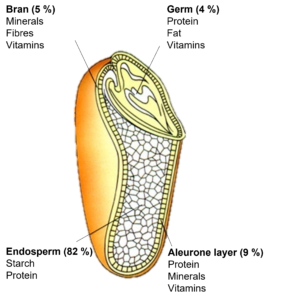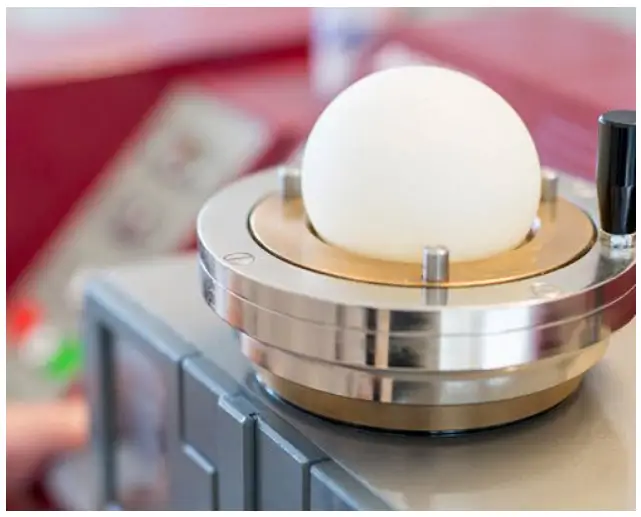
I am often asked which pizza flour is best for which pizza, whether the protein content is really so important and what this ominous W-value is all about. In this article, I would like to answer these questions and also show why flour is such an important basic ingredient for pizza baking.
Flour plays a significant role in pizza dough making, namely it determines the strength and elasticity of the dough. There are a few things to consider when it comes to flour, and my experience over the years has been that the choice of flour can have a big impact on the dough and the quality of the pizza.
Structure of a wheat grain
Without wanting to drift too much into theory, it can’t hurt to take a look at the structure of a wheat grain in order to better understand the background and connections to flour.

Roughly speaking, these are the three essential components of the wheat kernel:
- Bran as outer layer
- Germ
- Endosperm
The endosperm is also coated by the aleurone layer.
Degree of milling and baking ability of the flour
To produce flour, the grain kernel is milled. In this process, the whole grain is divided and the bran parts are separated from the endosperm. The degree of milling indicates the percentage of flour that can be obtained from a specified starting quantity of grain. A low degree of milling means that the endosperm and bran are strongly separated from each other, and mainly the endosperm is milled. This is the case with white flours such as type 405. In comparison, a high degree of milling indicates that more husk particles have been milled. This applies to darker flours such as type 1050 or wholemeal flour. This is also the reason for the designation of “white” and “dark” flours: the aleurone cells and husk parts with their minerals color the flour dark. The more aleurone cells and shell parts in the flour, the darker it is.
In the production of white wheat flour (e.g. the common type 405), most of the germ, the bran and also the aleurone layer are removed during the milling process, and what remains is the endosperm.
White flour therefore consists almost exclusively of the endosperm. This largely contains starch particles held together by protein structures (the so-called gluten). The gluten contained in the flour is a major factor in its baking properties because it binds water, among other things. White flour therefore has a high gluten and starch content. The absence of bran and germ increases the shelf life of white flour but also deprives it of its flavor component.
Wholemeal flour, as the name suggests, contains the whole grain and thus all three elements of bran, germ and endosperm, and is also more nutritious than the white wheat flour due to the minerals, fibres and vitamins it contains. A whole wheat dough is also “thirstier” because more water can be absorbed due to the additional contained bran and germ. However, the contained bran and the germ also weaken the gluten structure of the dough. Weakening in the sense that the gases produced with the help of the yeast cannot be retained as strongly in the dough. When the dough is baked in the oven, the gases can “escape” more easily and thus the dough does not rise as airy as a dough made from purely white flour. In exchange, whole wheat flour or even just the addition of whole wheat flour can add more flavor complexity.
At this point, I do not want to generalize or boil it down to the supposed formula
- White flour = airier dough, less flavor
- Dark flour = less airy dough, more complex taste
However, at least for me, learning more about this topics has given me a better understanding of why my doughs turned out the way they did.
German flour types
The designations commonly used in Germany for flour types 405 and 550 belong to a scale with several levels: 405, 550, 812, 1050, 1600. The level refers to the mineral content in the flour. The mineral content is also called ash because a small amount of flour is burned in a muffle oven to determine the type, and the ash is what remains at 900 °C for at least 6 hours. So, according to the logic, a wheat flour type 405 leaves 405 mg of ash after combustion related to the dry mass of the flour, which comes from the minerals. The higher the type number of the flour, the higher the mineral and fibre content, but in return, it also contains somewhat less starch and gluten.
Italian flour types
For Italian flour, there is a similar typification according to the Italian standard, which, however, differs from the values of DIN 10355 for German flour. The table below is nevertheless intended to venture a rough comparison.

However, it should be noted that in Italy there are different types of Tipo 00 flour: specifically for pasta, for bread, and for pizza. A Tipo 00 flour does not necessarily have to be intended specifically for pizza baking; in some Tipo 00 flours, this is also explicitly stated on the label. The protein content in Tipo 00 can be between 7% and 15%, depending on the manufacturer and purpose.
And while we’re on the subject: in Italy, wheat flour can be divided into durum wheat flour (it.: farina di grano duro or semola di grano duro) and soft wheat flour (it.: farina di grano tenero). For pizza baking, it is preferable to use soft wheat flour. However, durum wheat flour can be added (e.g. 10%) to make the pizza crispier and give it a more golden color. Semola is also used to spread the pizza, as it burns less quickly in the oven compared to soft wheat flour.
Durum wheat is used especially in pasta making, but also for baking bread, and provides the yellow color in these products.
Protein content in flour
The essential proteins in wheat flour are gliadin and glutenin. When water comes into contact with gliadin and glutenin, gluten is formed. Gluten is the network that holds the resulting gas bubbles in the dough together and makes the dough elastic.
The strength of a flour therefore speaks to its ability to absorb water during kneading and to retain carbon dioxide during fermentation (= air bubbles in the dough), and depends on the protein content of the flour (and therefore on the gluten produced). The stronger the flour, the more water it can absorb and the more carbon dioxide it can retain, which makes the dough airy. The dough is more resistant, elastic and airy due to the more stable gluten network, thus increasing the quality of the final product.
Whether it is flour for a Neapolitan or Roman pizza: you should pay attention to a high protein content: The protein content should be at least 12%, that is 12 grams per 100 grams. This information can be found in the nutritional table on the flour package. Of course, one cannot generalize, and I have also worked with very good flours that had “only” 11 grams of protein, but as a guideline I would stick to the 12 grams. The higher the water content of the dough, also called hydration, the more important a high protein content becomes.
There are also wheat varieties such as the Canadian Manitoba flour, which can contain up to 15 grams of protein and is therefore particularly suitable for doughs with long fermentation (e.g. panettone, ciabatta or even pizza).
W index
In addition to the protein content as a quality attribute of flour, one also reads or hears about the W index.
The W index, or flour strength index, is one of the most important parameters for evaluating the gluten strength and thus the influence on the extensibility of the dough. It is measured using Chopin’s Alveograph test, in which the dough is inflated like a balloon. The W index describes the energy required to burst the balloon.

In the EU regulation for Neapolitan pizza, for example, flours with W 220 – W 380 are specified.
The table below is intended to provide an orientation for suitable flours for pizza baking:

In contrast to the protein content, however, the information on the W index is rarely found on the flour but rather through internet research or on request from the mill. Even if the information on the W index of a flour is often not available: if you do find it it is definitely helpful, as it gives you a better idea of how the dough should be treated.
P/L index
And if that were not enough with all the indices and parameters, further criteria can be added, such as those for the resistance (P index) and elasticity (L index) of a flour.
The P/L index measures the rheological properties of the flour, e.g. its deformation and flow behavior. This is then used to determine the degree of balance between resistance and ductility. A balanced flour usually has an index between 0.40 and 0.70. An index above 0.70 indicates a tough flour, and below 0.40 is called an elastic flour.
For example, the EU regulation for Neapolitan pizza specifies flours with a ratio (P/L) of 0.50 – 0.70.
In my experience, it is even rarer to find the information on the P/L index for a flour, which is why the explanations on this parameter are intended more for information purposes.
Choosing the right pizza flour
The contents described in this article may at first glance seem very theoretical and especially irrelevant for beginners, but they are intended to illustrate the importance of flour in pizza baking and, above all, the complexity of the subject. In the end, a lot depends on the flour in pizza dough, such as the dough method (direct or indirect, meaning with or without pre-starter such as biga, poolish), the length of fermentation and the amount of water in the dough.
I think that, especially in the beginning, it is enough to concentrate on the protein content of the flour, or to follow the recommendations of others. And finally, it’s also a lot about trying things out yourself: testing different flours, water proportions, recipes and methods in order to form your own opinion and find the suitable flour.
If you don’t have the time or inclination to delve that deeply into flour for now and would rather get started right away, here are my top 5 flour tips to keep in mind:
- Protein content
Pay attention to the protein content of the flour. Ideally, it should be at least 12 grams per 100 grams. You can find the information on the protein content in the nutritional value table printed on the flour packaging. - Type of flour
After reading tip 1, you might think: great, whole wheat or spelt flours have a protein content of more than 12 grams. For the production of pizza dough I recommend – especially in the beginning – mainly the use of soft wheat flour. Of course, you can also make pizza dough with pure whole wheat or spelt flour or add to soft wheat flour, but the dough but also the pizza will then be different in texture and also taste different. - Tipo indication
The Tipo indication is derived from the Italian typification for flours and is also indicated on the packaging of pizza flours. The choice of the right Tipo flour depends on the type of dough, among other things the duration of the resting of the dough, pre-dough, and the level of water content in the dough. Although it is not possible to generalize, I recommend Tipo 00 or Tipo 0 flour for pizza dough. It does not hurt to take a closer look at the flour packaging or the product description, e.g. whether the dough is suitable for longer rests. - W index
The W index indicates the baking strength of flour, i.e. how elastic the dough can be. A low W index is a flour that is weak in baking, a high W index describes a flour that is strong in baking. Again, I don’t want to talk about rules of thumb, but roughly you should orient yourself at a W index of at least W220. If you don’t find the W index on the flour packaging, I advise you to do a Google search. - Try out different things
Last but not least, I would like to encourage you to try different flours and make up your own mind and come to your own taste. Feel free to mix flours too!
I would like to emphasize at this point that the tips should not be considered as stand-alone, i.e. “only tips 1 and 2 are important”, but in the best case tips 1-4 apply to a flour.
Our pizza flour recommendations
We often get asked about our favorite flours or which ones we can particularly recommend. This question is no longer so easy to answer due to the increasing selection of pizza flours and also depends on the type of pizza you want to bake. Here we would like to show you a selection of our pizza flour recommendations with which we have had particularly good experiences. Of course, we could make it easy for ourselves and list all the possible flour brands that are available on the market – but this is not our claim. We have tested all the flours mentioned here several times ourselves and would therefore recommend them without reservation.
When testing new flours, we follow the top 5 flour tips outlined above.
Flour for Neapolitan Pizza
The flours mentioned here are particularly suitable for pizzas with a water content of about 60%-70% and resting times of 8 hours up to a maximum of 72 hours.
We also recommend the following flours. If you manage to get a hold of one of these, make sure to try to them out!
- Caputo Cuoco/Saccorosso
- Caputo Nuvola
- Dallagiovanna La Napoletana
- Molini Pizzuti Costa d’Amalfi
Flour for pan pizzas or pizzas with pre-doughs
The dough for pan pizzas (e.g. Pizza in Teglia, Detroit Style Pizza, Focaccia) is characterized by high water content. As already described above, this means that the flour ideally should have a high protein content and W-Value. In addition, pizza with a pre-dough (poolish, biga) requires the flour to have similar properties, as it usually goes through longer resting periods. Therefore, the flours mentioned here are suitable for both doughs with high hydration and doughs with a pre-dough. These flours are suitable for doughs with water content up to 85% and longer resting periods from 48 hours up to 96 hours (and theoretically even longer).
- Caputo Cuoco/Saccorosso
- Frießinger Mühle La Farina 14
- Molini Pizzuti Vesuvio
- Molino Quaglia Petra 5037
- Polselli Super
Discover more
You’d like to start making pizza right away, but you’re wondering where to start? We have summarized the most important information on the following page for you.
Thanks for reading! I hope this page about pizza flour was valuable to you. If you have any unanswered questions, feel free to let me know in the comments. I’d appreciate it if you could share this article with your friends.
Julia
